2013 NISSAN FRONTIER coolant temperature
[x] Cancel search: coolant temperaturePage 341 of 444
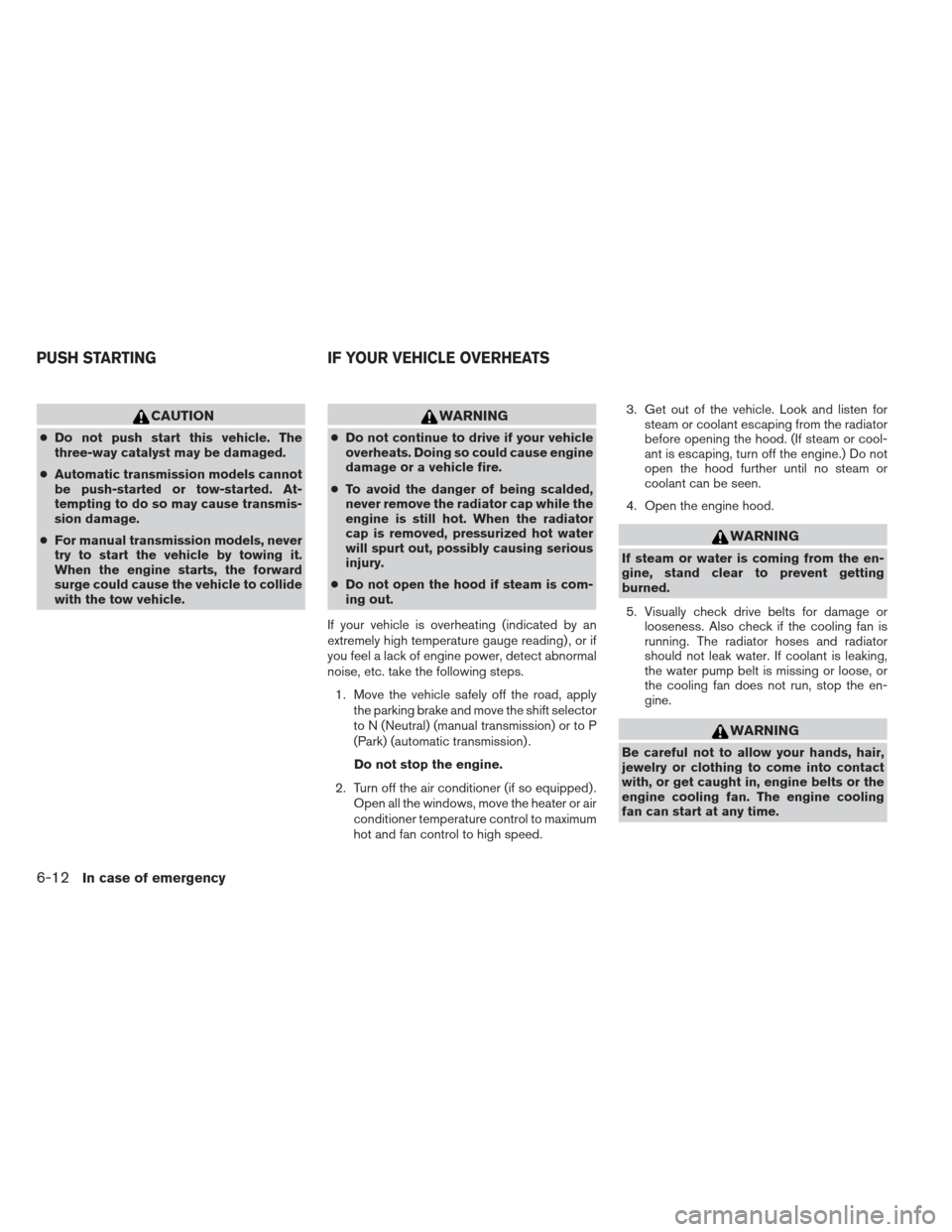
CAUTION
●Do not push start this vehicle. The
three-way catalyst may be damaged.
● Automatic transmission models cannot
be push-started or tow-started. At-
tempting to do so may cause transmis-
sion damage.
● For manual transmission models, never
try to start the vehicle by towing it.
When the engine starts, the forward
surge could cause the vehicle to collide
with the tow vehicle.
WARNING
● Do not continue to drive if your vehicle
overheats. Doing so could cause engine
damage or a vehicle fire.
● To avoid the danger of being scalded,
never remove the radiator cap while the
engine is still hot. When the radiator
cap is removed, pressurized hot water
will spurt out, possibly causing serious
injury.
● Do not open the hood if steam is com-
ing out.
If your vehicle is overheating (indicated by an
extremely high temperature gauge reading) , or if
you feel a lack of engine power, detect abnormal
noise, etc. take the following steps. 1. Move the vehicle safely off the road, apply the parking brake and move the shift selector
to N (Neutral) (manual transmission) or to P
(Park) (automatic transmission) .
Do not stop the engine.
2. Turn off the air conditioner (if so equipped) . Open all the windows, move the heater or air
conditioner temperature control to maximum
hot and fan control to high speed. 3. Get out of the vehicle. Look and listen for
steam or coolant escaping from the radiator
before opening the hood. (If steam or cool-
ant is escaping, turn off the engine.) Do not
open the hood further until no steam or
coolant can be seen.
4. Open the engine hood.
WARNING
If steam or water is coming from the en-
gine, stand clear to prevent getting
burned.
5. Visually check drive belts for damage or looseness. Also check if the cooling fan is
running. The radiator hoses and radiator
should not leak water. If coolant is leaking,
the water pump belt is missing or loose, or
the cooling fan does not run, stop the en-
gine.
WARNING
Be careful not to allow your hands, hair,
jewelry or clothing to come into contact
with, or get caught in, engine belts or the
engine cooling fan. The engine cooling
fan can start at any time.
PUSH STARTING IF YOUR VEHICLE OVERHEATS
6-12In case of emergency
Page 355 of 444
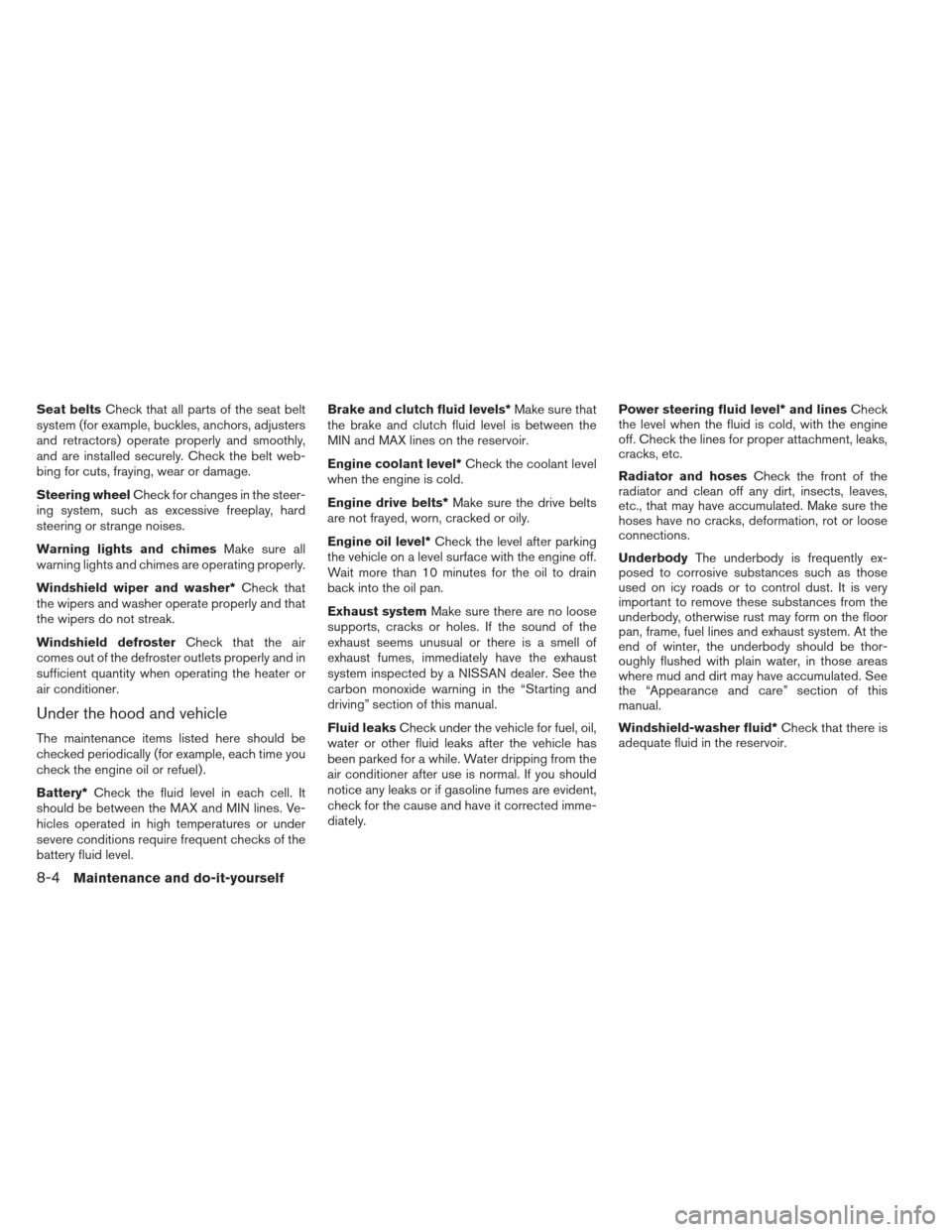
Seat beltsCheck that all parts of the seat belt
system (for example, buckles, anchors, adjusters
and retractors) operate properly and smoothly,
and are installed securely. Check the belt web-
bing for cuts, fraying, wear or damage.
Steering wheel Check for changes in the steer-
ing system, such as excessive freeplay, hard
steering or strange noises.
Warning lights and chimes Make sure all
warning lights and chimes are operating properly.
Windshield wiper and washer* Check that
the wipers and washer operate properly and that
the wipers do not streak.
Windshield defroster Check that the air
comes out of the defroster outlets properly and in
sufficient quantity when operating the heater or
air conditioner.
Under the hood and vehicle
The maintenance items listed here should be
checked periodically (for example, each time you
check the engine oil or refuel) .
Battery* Check the fluid level in each cell. It
should be between the MAX and MIN lines. Ve-
hicles operated in high temperatures or under
severe conditions require frequent checks of the
battery fluid level. Brake and clutch fluid levels*
Make sure that
the brake and clutch fluid level is between the
MIN and MAX lines on the reservoir.
Engine coolant level* Check the coolant level
when the engine is cold.
Engine drive belts* Make sure the drive belts
are not frayed, worn, cracked or oily.
Engine oil level* Check the level after parking
the vehicle on a level surface with the engine off.
Wait more than 10 minutes for the oil to drain
back into the oil pan.
Exhaust system Make sure there are no loose
supports, cracks or holes. If the sound of the
exhaust seems unusual or there is a smell of
exhaust fumes, immediately have the exhaust
system inspected by a NISSAN dealer. See the
carbon monoxide warning in the “Starting and
driving” section of this manual.
Fluid leaks Check under the vehicle for fuel, oil,
water or other fluid leaks after the vehicle has
been parked for a while. Water dripping from the
air conditioner after use is normal. If you should
notice any leaks or if gasoline fumes are evident,
check for the cause and have it corrected imme-
diately. Power steering fluid level* and lines
Check
the level when the fluid is cold, with the engine
off. Check the lines for proper attachment, leaks,
cracks, etc.
Radiator and hoses Check the front of the
radiator and clean off any dirt, insects, leaves,
etc., that may have accumulated. Make sure the
hoses have no cracks, deformation, rot or loose
connections.
Underbody The underbody is frequently ex-
posed to corrosive substances such as those
used on icy roads or to control dust. It is very
important to remove these substances from the
underbody, otherwise rust may form on the floor
pan, frame, fuel lines and exhaust system. At the
end of winter, the underbody should be thor-
oughly flushed with plain water, in those areas
where mud and dirt may have accumulated. See
the “Appearance and care” section of this
manual.
Windshield-washer fluid* Check that there is
adequate fluid in the reservoir.
8-4Maintenance and do-it-yourself
Page 429 of 444
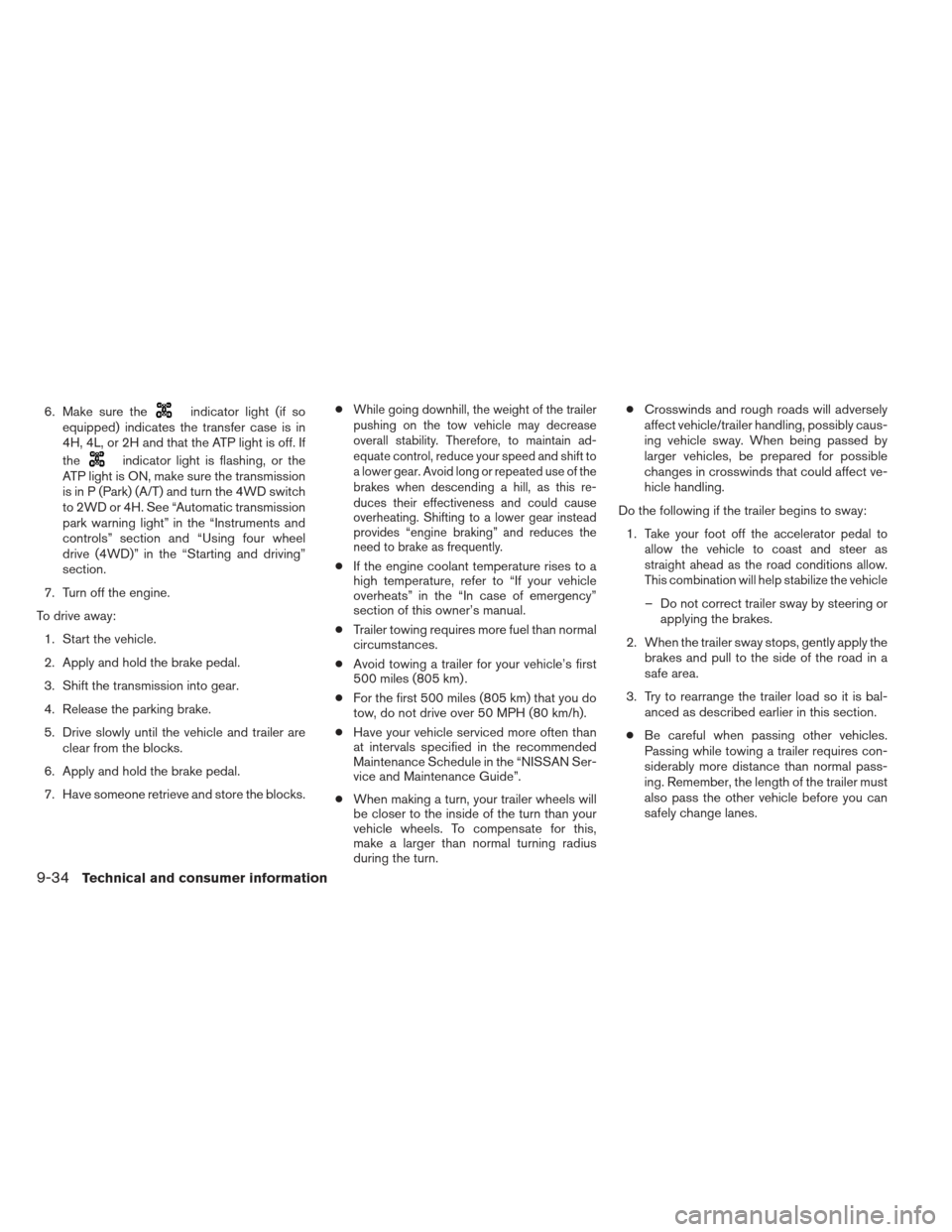
6. Make sure theindicator light (if so
equipped) indicates the transfer case is in
4H, 4L, or 2H and that the ATP light is off. If
the
indicator light is flashing, or the
ATP light is ON, make sure the transmission
is in P (Park) (A/T) and turn the 4WD switch
to 2WD or 4H. See “Automatic transmission
park warning light” in the “Instruments and
controls” section and “Using four wheel
drive (4WD)” in the “Starting and driving”
section.
7. Turn off the engine.
To drive away: 1. Start the vehicle.
2. Apply and hold the brake pedal.
3. Shift the transmission into gear.
4. Release the parking brake.
5. Drive slowly until the vehicle and trailer are clear from the blocks.
6. Apply and hold the brake pedal.
7. Have someone retrieve and store the blocks. ●
While going downhill, the weight of the trailer
pushing on the tow vehicle may decrease
overall stability. Therefore, to maintain ad-
equate control, reduce your speed and shift to
a lower gear. Avoid long or repeated use of the
brakes when descending a hill, as this re-
duces their effectiveness and could cause
overheating. Shifting to a lower gear instead
provides “engine braking” and reduces the
need to brake as frequently.
● If the engine coolant temperature rises to a
high temperature, refer to “If your vehicle
overheats” in the “In case of emergency”
section of this owner’s manual.
● Trailer towing requires more fuel than normal
circumstances.
● Avoid towing a trailer for your vehicle’s first
500 miles (805 km) .
● For the first 500 miles (805 km) that you do
tow, do not drive over 50 MPH (80 km/h).
● Have your vehicle serviced more often than
at intervals specified in the recommended
Maintenance Schedule in the “NISSAN Ser-
vice and Maintenance Guide”.
● When making a turn, your trailer wheels will
be closer to the inside of the turn than your
vehicle wheels. To compensate for this,
make a larger than normal turning radius
during the turn. ●
Crosswinds and rough roads will adversely
affect vehicle/trailer handling, possibly caus-
ing vehicle sway. When being passed by
larger vehicles, be prepared for possible
changes in crosswinds that could affect ve-
hicle handling.
Do the following if the trailer begins to sway: 1.
Take your foot off the accelerator pedal to
allow the vehicle to coast and steer as
straight ahead as the road conditions allow.
This combination will help stabilize the vehicle
– Do not correct trailer sway by steering or applying the brakes.
2. When the trailer sway stops, gently apply the brakes and pull to the side of the road in a
safe area.
3. Try to rearrange the trailer load so it is bal- anced as described earlier in this section.
● Be careful when passing other vehicles.
Passing while towing a trailer requires con-
siderably more distance than normal pass-
ing. Remember, the length of the trailer must
also pass the other vehicle before you can
safely change lanes.
9-34Technical and consumer information
Page 437 of 444
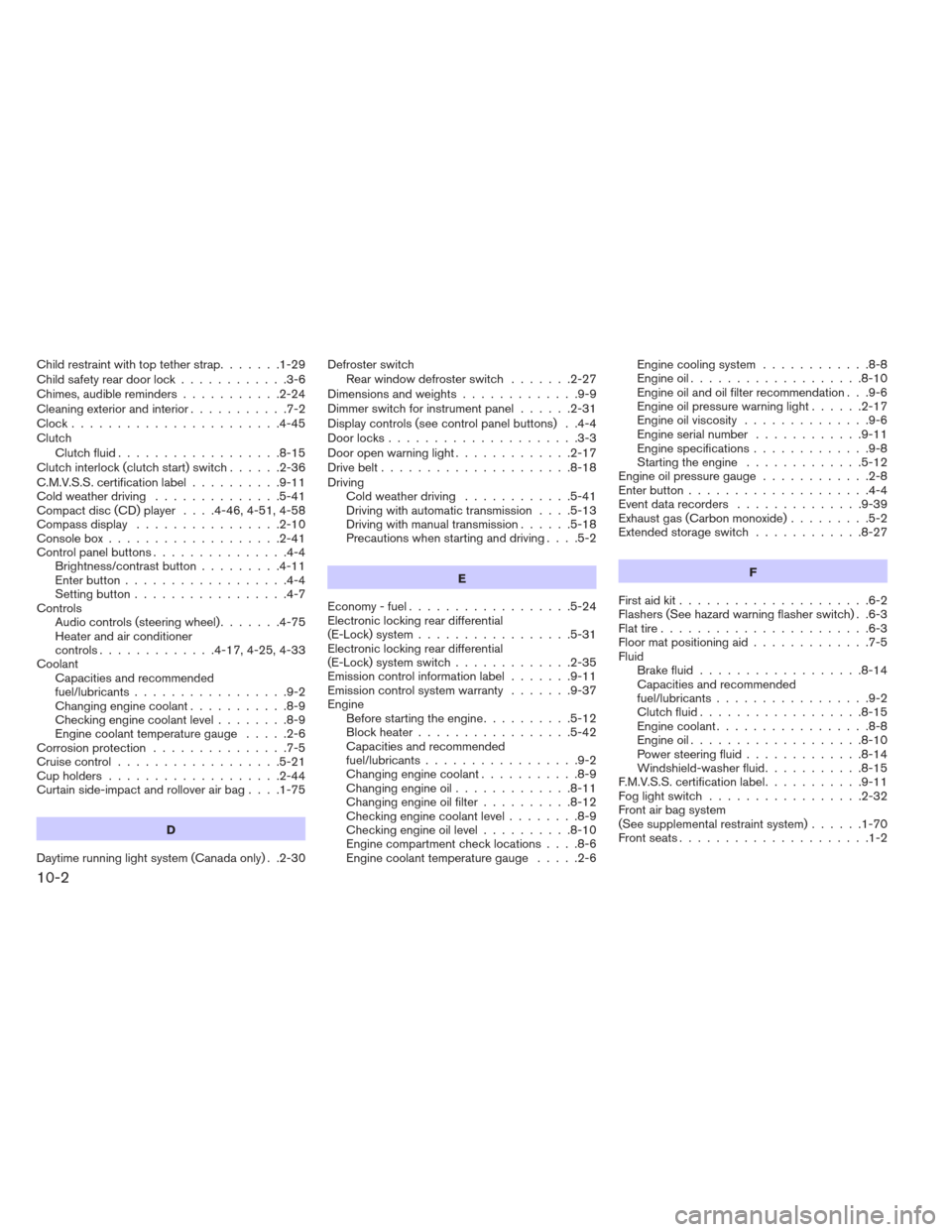
Child restraint with top tether strap.......1-29
Child safety rear door lock ............3-6
Chimes, audible reminders ...........2-24
Cleaningexteriorandinterior...........7-2
Clock.......................4-45
Clutch Clutchfluid..................8-15
Clutchinterlock(clutchstart)switch......2-36
C.M.V.S.S. certification label ..........9-11
Cold weather driving ..............5-41
Compact disc (CD) player ....4-46,4-51,4-58
Compass display ................2-10
Console box ...................2-41
Controlpanelbuttons...............4-4 Brightness/contrast button .........4-11
Enterbutton..................4-4
Setting button .................4-7
Controls Audiocontrols(steeringwheel).......4-75
Heater and air conditioner
controls .............4-17,4-25,4-33
Coolant Capacities and recommended
fuel/lubricants .................9-2
Changing engine coolant ...........8-9
Checking engine coolant level ........8-9
Engine coolant temperature gauge .....2-6
Corrosionprotection ...............7-5
Cruise control ..................5-21
Cupholders...................2-44
Curtain side-impact and rollover air bag ....1-75
D
Daytime running light system (Canada only) . .2-30 Defroster switch
Rear window defroster switch .......2-27
Dimensionsandweights.............9-9
Dimmer switch for instrument panel ......2-31
Display controls (see control panel buttons) . .4-4
Door locks .....................3-3
Door open warning light .............2-17
Drive belt .....................8-18
Driving Cold weather driving ............5-41
Driving with automatic transmission ....5-13
Driving with manual transmission ......5-18
Precautions when starting and driving ....5-2
E
Economy - fuel ..................5-24
Electronic locking rear differential
(E-Lock) system .................5-31
Electronic locking rear differential
(E-Lock) system switch .............2-35
Emission control information label .......9-11
Emission control system warranty .......9-37
Engine Before starting the engine ..........5-12
Block heater .................5-42
Capacities and recommended
fuel/lubricants .................9-2
Changing engine coolant ...........8-9
Changing engine oil .............8-11
Changing engine oil filter ..........8-12
Checking engine coolant level ........8-9
Checking engine oil level ..........8-10
Engine compartment check locations ....8-6
Engine coolant temperature gauge .....2-6Engine cooling system
............8-8
Engine oil ...................8-10
Engine oil and oil filter recommendation . . .9-6
Engine oil pressure warning light ......2-17
Engine oil viscosity ..............9-6
Engine
serial number ............9-11
Engine specifications .............9-8
Starting the engine .............5-12
Engine oil pressure gauge ............2-8
Enterbutton....................4-4
Eventdatarecorders ..............9-39
Exhaust gas (Carbon monoxide) .........5-2
Extended storage switch ............8-27
F
First aid kit .....................6-2
Flashers (See hazard warning flasher switch) . .6-3
Flat tire .......................6-3
Floor mat positioning aid .............7-5
Fluid Brake fluid ..................8-14
Capacities and recommended
fuel/lubricants .................9-2
Clutch fluid ..................8-15
Engine coolant .................8-8
Engine oil ...................8-10
Power steering fluid .............8-14
Windshield-washer fluid ...........8-15
F.M.V.S.S. certification label ...........9-11
Foglightswitch .................2-32
Front air bag system
(See supplemental restraint system) ......1-70
Front seats .....................1-2
10-2
Page 438 of 444
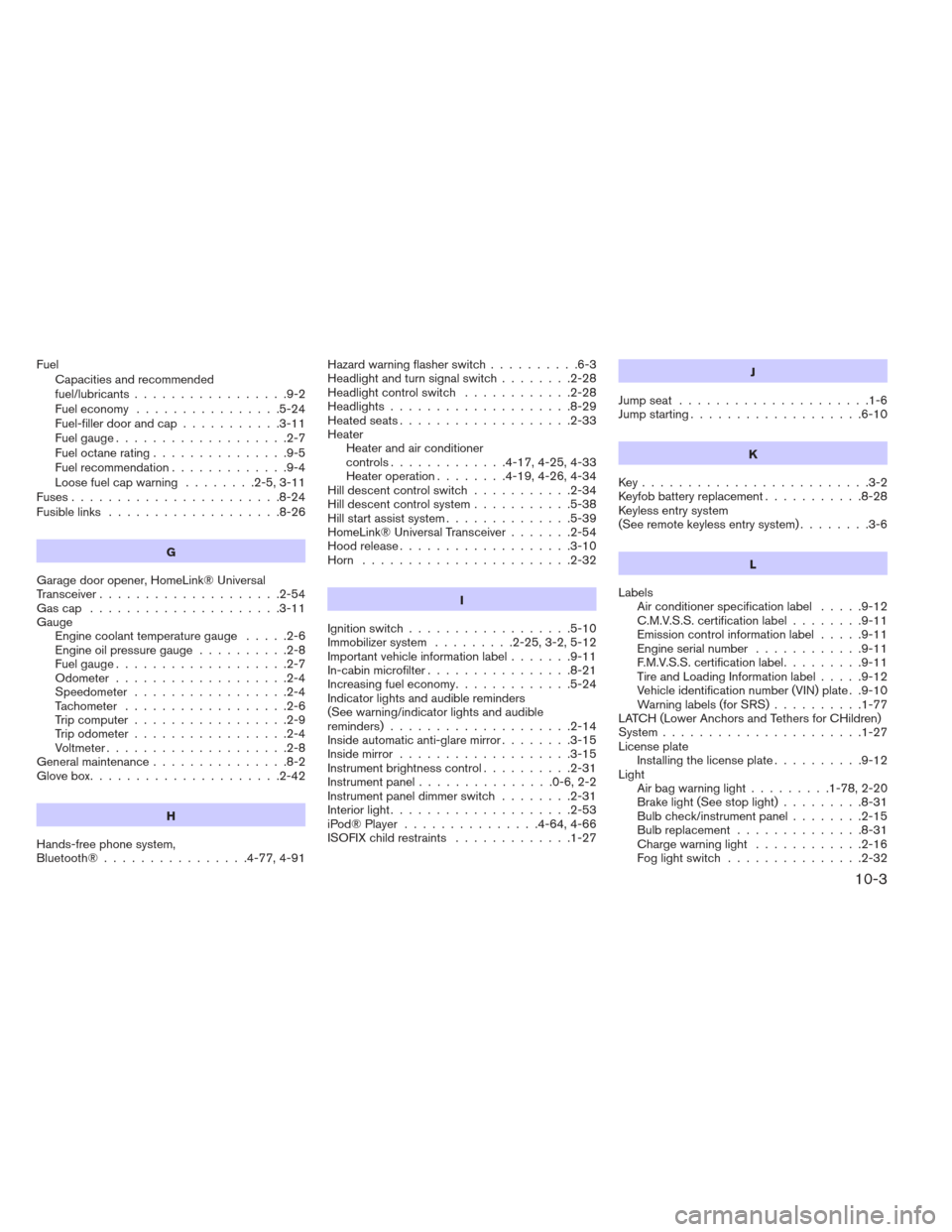
FuelCapacities and recommended
fuel/lubricants .................9-2
Fuel economy ................5-24
Fuel-filler door and cap ...........3-11
Fuel gauge ...................2-7
Fueloctanerating...............9-5
Fuel recommendation .............9-4
Loosefuelcapwarning ........2-5,3-11
Fuses.......................8-24
Fusiblelinks ...................8-26
G
Garage door opener, HomeLink® Universal
Transceiver....................2-54
Gascap .....................3-11
Gauge Engine coolant temperature gauge .....2-6
Engine oil pressure gauge ..........2-8
Fuel gauge ...................2-7
Odometer ...................2-4
Speedometer .................2-4
Tachometer ..................2-6
Trip computer .................2-9
Trip odometer .................2-4
Voltmeter....................2-8
Generalmaintenance...............8-2
Glovebox.....................2-42
H
Hands-free phone system,
Bluetooth®................4-77,4-91 Hazard warning flasher switch
..........6-3
Headlight and turn signal switch ........2-28
Headlight control switch ............2-28
Headlights ....................8-29
Heated seats ...................2-33
Heater Heater and air conditioner
controls.............4-17,4-25,4-33
Heater operation ........4-19,4-26,4-34
Hill descent control switch ...........2-34
Hill descent control system ...........5-38
Hill start assist system ..............5-39
HomeLink® Universal Transceiver .......2-54
Hood release ...................3-10
Horn .......................2-32
I
Ignition switch ..................5-10
Immobilizer system .........2-25,3-2,5-12
Important vehicle information label .......9-11
In-cabin microfilter ................8-21
Increasing fuel economy .............5-24
Indicator lights and audible reminders
(See warning/indicator lights and audible
reminders)....................2-14
Inside automatic anti-glare mirror ........3-15
Inside mirror ...................3-15
Instrument brightness control ..........2-31
Instrument panel ...............0-6,2-2
Instrument panel dimmer switch ........2-31
Interiorlight....................2-53
iPod® Player ...............4-64,4-66
ISOFIX child restraints .............1-27 J
Jumpseat .....................1-6
Jump starting ...................6-10
K
Key.........................3-2
Keyfob battery replacement ...........8-28
Keyless entry system
(See remote keyless entry system) ........3-6
L
Labels Air conditioner specification label .....9-12
C.M.V.S.S. certification label ........9-11
Emission
control information label .....9-11
Engine serial number ............9-11
F.M.V.S.S. certification label .........9-11
Tire and Loading Information label .....9-12
Vehicle identification number (VIN) plate . .9-10
Warning labels (for SRS) ..........1-77
LATCH (Lower Anchors and Tethers for CHildren)
System ......................1-27
License plate Installing the license plate ..........9-12
Light Airbagwarninglight.........1-78, 2-20
Brake light (See stop light) .........8-31
Bulb check/instrument panel ........2-15
Bulbreplacement..............8-31
Charge warning light ............2-16
Fog light switch ...............2-32
10-3
Page 441 of 444
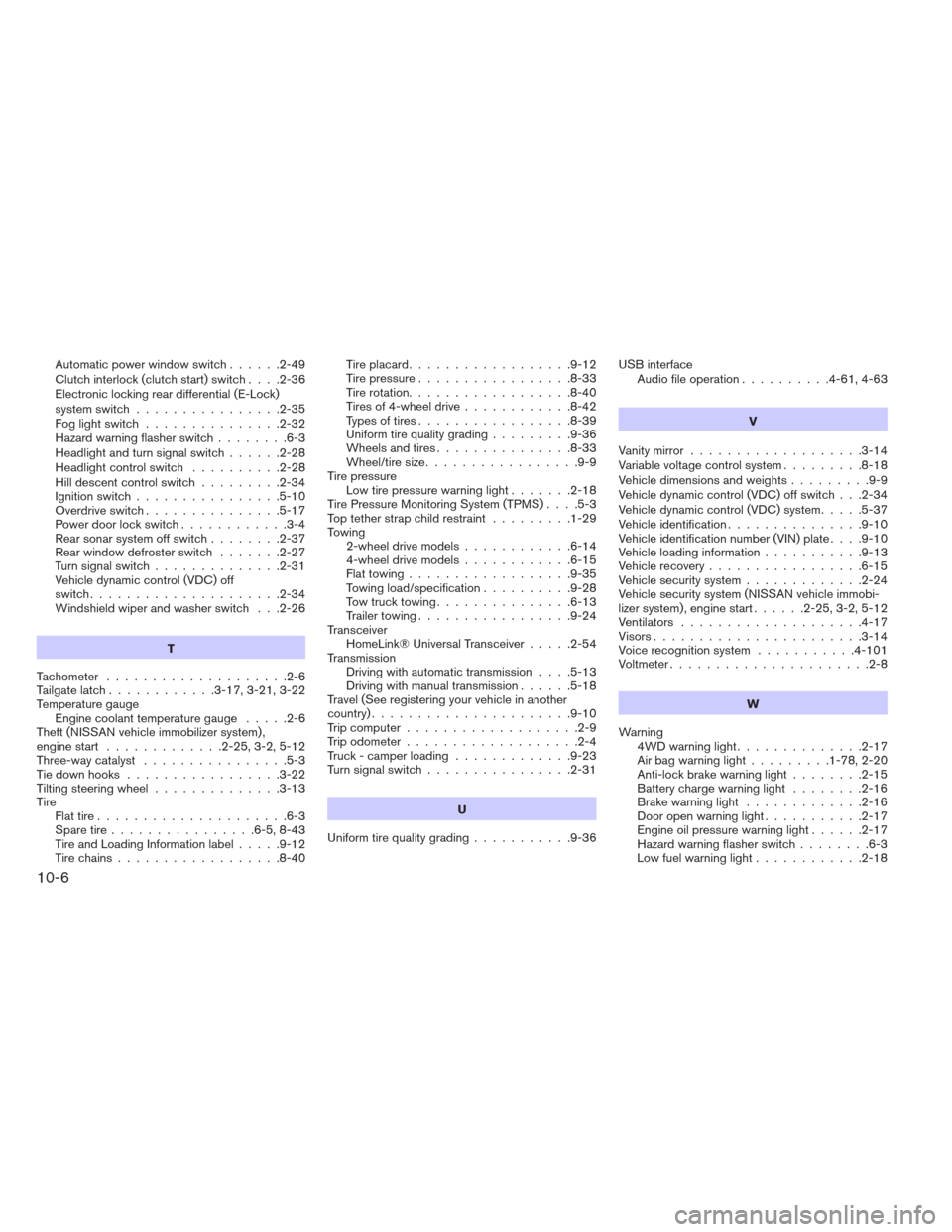
Automatic power window switch......2-49
Clutch interlock (clutch start) switch ....2-36
Electronic locking rear differential (E-Lock)
systemswitch................2-35
Foglightswitch ...............2-32
Hazard warning flasher switch ........6-3
Headlight and turn signal switch ......2-28
Headlightcontrolswitch ..........2-28
Hill descent control switch .........2-34
Ignition switch ................5-10
Overdrive switch ...............5-17
Power door lock switch ............3-4
Rear sonar system off switch ........2-37
Rear window defroster switch .......2-27
Turnsignalswitch..............2-31
Vehicle dynamic control (VDC) off
switch.....................2-34
Windshield wiper and washer switch . . .2-26
T
Tachometer ....................2-6
Tailgate latch ............3-17,3-21,3-22
Temperature gauge Engine coolant temperature gauge .....2-6
Theft (NISSAN vehicle immobilizer system) ,
engine start .............2-25,3-2,5-12
Three-way catalyst ................5-3
Tie down hooks .................3-22
Tilting steering wheel ..............3-13
Tire Flat tire .....................6-3
Spare tire ................6-5,8-43
Tire and Loading Information label .....9-12
Tire chains ..................8-40 Tireplacard..................9-12
Tire pressure
.................8-33
Tire rotation..................8-40
Tires of 4-wheel drive ............8-42
Types of tires .................8-39
Uniform tire quality grading .........9-36
Wheels and tires ...............8-33
Wheel/tire size .................9-9
Tire pressure Low tire pressure warning light .......2-18
Tire Pressure Monitoring System (TPMS) ....5-3
Top tether strap child restraint .........1-29
Towing 2-wheel drive models ............6-14
4-wheel drive models ............6-15
Flattowing..................9-35
Towing load/specification ..........9-28
Towtrucktowing...............6-13
Trailer towing .................9-24
Transceiver HomeLink® Universal Transceiver .....2-54
Transmission Driving with automatic transmission ....5-13
Driving with manual transmission ......5-18
Travel (See registering your vehicle in another
country) ......................9-10
Trip computer ...................2-9
Trip odometer ...................2-4
Truck - camper loading .............9-23
Turn signal switch ................2-31
U
Uniform tire quality grading ...........9-36USB interface
Audio file operation ..........4-61,4-63
V
V
anity mirror ...................3-14
Variable voltage control system .........8-18
Vehicledimensionsandweights.........9-9
Vehicle dynamic control (VDC) off switch . . .2-34
Vehicle dynamic control (VDC) system .....5-37
Vehicle identification ...............9-10
Vehicle identification number (VIN) plate ....9-10
Vehicleloadinginformation...........9-13
Vehicle recovery .................6-15
Vehicle security system .............2-24
Vehicle security system (NISSAN vehicle immobi-
lizer system) , engine start ......2-25,3-2,5-12
Ventilators ....................4-17
Visors.......................3-14
Voice recognition system ...........4-101
Voltmeter......................2-8
W
Warning 4WDwarninglight..............2-17
Airbagwarninglight.........1-78, 2-20
Anti-lock brake warning light ........2-15
Battery charge warning light ........2-16
Brake warning light .............2-16
Door open warning light ...........2-17
Engine oil pressure warning light ......2-17
Hazard warning flasher switch ........6-3
Low fuel warning light ............2-18
10-6